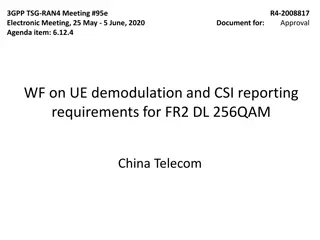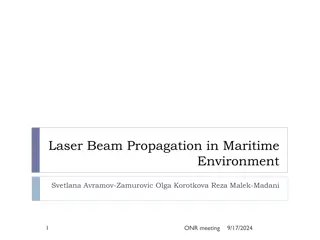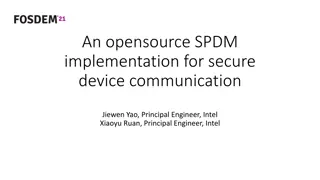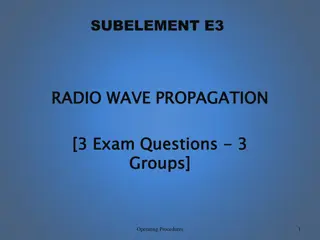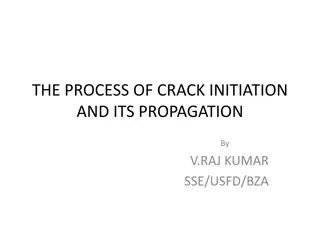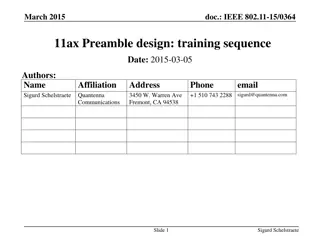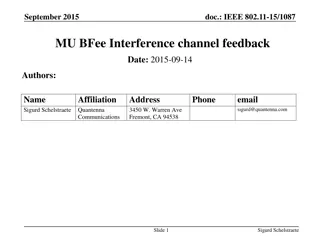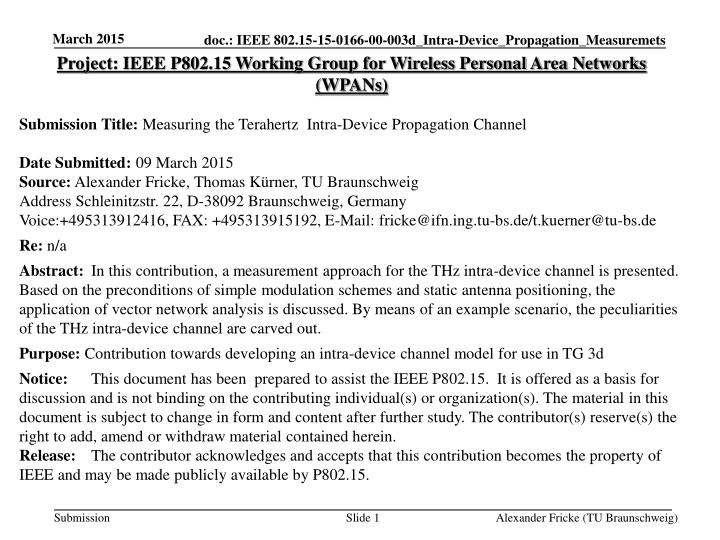
Measuring Terahertz Intra-Device Propagation Channel - IEEE 802.15
"Explore the measurement approach for the Terahertz intra-device channel presented in this IEEE document. Understand the channel characteristics, modulation schemes, and antenna positioning for developing an intra-device channel model for wireless personal area networks (WPANs)."
Download Presentation

Please find below an Image/Link to download the presentation.
The content on the website is provided AS IS for your information and personal use only. It may not be sold, licensed, or shared on other websites without obtaining consent from the author. If you encounter any issues during the download, it is possible that the publisher has removed the file from their server.
You are allowed to download the files provided on this website for personal or commercial use, subject to the condition that they are used lawfully. All files are the property of their respective owners.
The content on the website is provided AS IS for your information and personal use only. It may not be sold, licensed, or shared on other websites without obtaining consent from the author.
E N D
Presentation Transcript
March 2015 doc.: IEEE 802.15-15-0166-00-003d_Intra-Device_Propagation_Measuremets Project: IEEE P802.15 Working Group for Wireless Personal Area Networks (WPANs) Submission Title: Measuring the Terahertz Intra-Device Propagation Channel Date Submitted: 09 March 2015 Source: Alexander Fricke, Thomas K rner, TU Braunschweig Address Schleinitzstr. 22, D-38092 Braunschweig, Germany Voice:+495313912416, FAX: +495313915192, E-Mail: fricke@ifn.ing.tu-bs.de/t.kuerner@tu-bs.de Re: n/a Abstract: In this contribution, a measurement approach for the THz intra-device channel is presented. Based on the preconditions of simple modulation schemes and static antenna positioning, the application of vector network analysis is discussed. By means of an example scenario, the peculiarities of the THz intra-device channel are carved out. Purpose: Contribution towards developing an intra-device channel model for use in TG 3d Notice: This document has been prepared to assist the IEEE P802.15. It is offered as a basis for discussion and is not binding on the contributing individual(s) or organization(s). The material in this document is subject to change in form and content after further study. The contributor(s) reserve(s) the right to add, amend or withdraw material contained herein. Release: The contributor acknowledges and accepts that this contribution becomes the property of IEEE and may be made publicly available by P802.15. Submission Slide 1 Alexander Fricke (TU Braunschweig)
March 2015 doc.: IEEE 802.15-15-0166-00-003d_Intra-Device_Propagation_Measuremets Measuring the Terahertz Intra-Device Propagation Channel Alexander Fricke, Thomas K rner TU Braunschweig Submission Slide 2 Alexander Fricke (TU Braunschweig)
March 2015 doc.: IEEE 802.15-15-0166-00-003d_Intra-Device_Propagation_Measuremets Outline Motivation Measurement Approach Example Scenario Observations Conclusion & Outlook Submission Slide 3 Alexander Fricke (TU Braunschweig)
May 2014 doc.: IEEE 802.15-15-0166-00-003d_Intra-Device_Propagation_Measuremets Motivation (1/2) - Intra-Device Communication at THz Frequencies Ever increasing demand for higher wireless data rates, 100 Gbit/s estimated for 2020. Huge available bandwidths above 300 GHz can provide these data rates. Short wave lengths of several millimeters and less enable intra device communications from chip to chip with integrated antennas. Need to investigate the propagation characteristics with typical structures and materials for intra device links Submission Slide 4 Alexander Fricke (TU Braunschweig)
March 2015 doc.: IEEE 802.15-15-0166-00-003d_Intra-Device_Propagation_Measuremets Motivation (2/2) - Channel Measurements Inside a Mock-Up Several propagation mechanisms relevant for intra-device propagation have been investigated However, in order to develop a model for the intra-device propagation channel, an idea of the complete channel behavior is necessary The straightforward approach is thus the measurement of several well- defined propagation scenarios 0 0 Submission Slide 5 Alexander Fricke (TU Braunschweig)
March 2015 doc.: IEEE 802.15-15-0166-00-003d_Intra-Device_Propagation_Measuremets Measurement Approach (Setup) Targeted PHY data rate of 100 Gbps with low-complexity modulation schemes Frequency Division / Spatial Division Multiplexing Point-to-point communications between static antennas with known positions allow for simple MAC layer implementation To fully characterize the channel, frequency domain measurements using a vector network analyzer with frequency extensions are performed VNA Rohde&Schwarz ZVA 50 Rohde&Schwarz ZVA-Z325 Rohde&Schwarz ZVA-Z325 DUT Antennas: Flann Microwave Model 32240-20 The channel transfer function (CTF) is measured over a bandwidth of e.g. 50 GHz and is then evaluated in terms of channel impulse responses (CIR) for frequency bands of e.g. 10 GHz bandwidth Submission
March 2015 doc.: IEEE 802.15-15-0166-00-003d_Intra-Device_Propagation_Measuremets Measurement Approach (Procedure) Absorbers Rohde & Schwarz ZVA50 with Frequency Extensions Mock-Up: Standard Gain Horns Absorbing Foil Submission Slide 7 Alexander Fricke (TU Braunschweig)
March 2015 doc.: IEEE 802.15-15-0166-00-003d_Intra-Device_Propagation_Measuremets Measurement Approach (Evaluation) Varying Echos FFT Leakage Due to the large total bandwidth of 50GHz, the CIR of the sub-bands varies The impact of FFT leakage must be compensated, e.g. using appropriate filter functions Submission
March 2015 doc.: IEEE 802.15-15-0166-00-003d_Intra-Device_Propagation_Measuremets Example Scenario: Direct Transmission As a first example, the case of board-to-board communication with no obstructions between the antennas has been measured As seen below, four configurations with diagonal antenna positioning have been measured featuring both varying box size and number of printed circuit boards Further scenarios must be defined to create a comprehensive channel model PCBs Submission
March 2015 doc.: IEEE 802.15-15-0166-00-003d_Intra-Device_Propagation_Measuremets Observations for Direct Transmission: Full BW ABS Walls PCB Walls Small Box d = 5cm Large Box d = 16cm Submission Slide 10 Thomas K rner (TU Braunschweig)
March 2015 doc.: IEEE 802.15-15-0166-00-003d_Intra-Device_Propagation_Measuremets Observations for Direct Transmission: Band 1 ABS Walls PCB Walls Small Box d = 5cm Large Box d = 16cm Submission Slide 11 Thomas K rner (TU Braunschweig)
March 2015 doc.: IEEE 802.15-15-0166-00-003d_Intra-Device_Propagation_Measuremets Observations for Direct Transmission: Band 3 ABS Walls PCB Walls Small Box d = 5cm Large Box d = 16cm Submission Slide 12 Thomas K rner (TU Braunschweig)
March 2015 doc.: IEEE 802.15-15-0166-00-003d_Intra-Device_Propagation_Measuremets Observations for Direct Transmission Generally, one dominant path corresponding to the direct link between Tx and Rx Several distinct reflected propagation paths following the main peak All reflected paths are generally more than 20dB weaker than the main signal The amplitude of reflected paths varies significantly between sub-bands For narrower environments, the multipath richness of the CIR is reduced Signal degradation can be observed if the line of sight is obstructed in the small box Submission Slide 13 Thomas K rner (TU Braunschweig)
March 2015 doc.: IEEE 802.15-15-0166-00-003d_Intra-Device_Propagation_Measuremets Conclusion & Outlook Channel characterization in frequency domain is necessary to account for possible multiple sub-bands as well as frequency dispersion FFT Leakage must possibly be supressed using filter techniques The effects of both the plastic casing and the PCB building parts play a significant role for intra-device propagation modelling The behavior of the sub-bands may vary significantly Additional scenario definitions need to be developed for the complete channel model, e.g. chip-to-chip communication Submission Alexander Fricke (TU Braunschweig) Slide 14
March 2015 doc.: IEEE 802.15-15-0166-00-003d_Intra-Device_Propagation_Measuremets Thank You for Your Attention Submission Slide 15 Alexander Fricke (TU Braunschweig)








